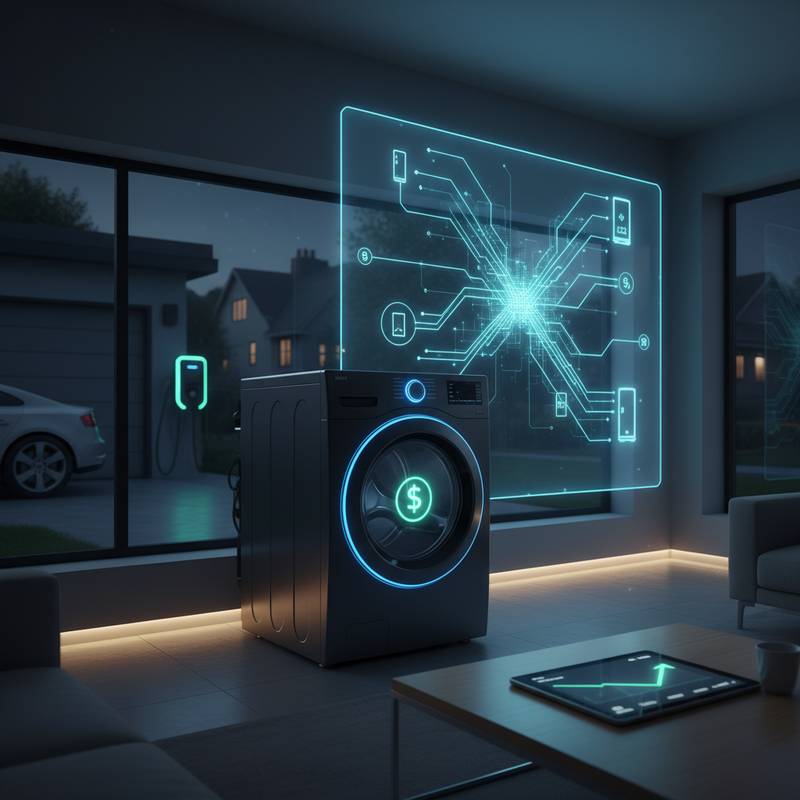Appliances in Sync with the Energy Grid
Consider a smart washer, a networked thermostat, and a refrigerator that notifies your phone of issues. These devices conserve time and energy, yet they possess greater potential. Picture your household seamlessly aligning with the local utility grid, curtailing power consumption during high-rate periods and resuming when electricity costs decline, all without intervention.
This concept has transitioned from speculation to reality. Smart appliances now integrate with utility systems to facilitate demand response, a method that stabilizes the grid and diminishes energy bills. This evolution positions typical residences as proactive contributors to energy oversight.
Challenges in Electricity Consumption
Power demand fluctuates significantly. Simultaneous operation of air conditioners or electric vehicle charging overwhelms the grid, prompting utilities to activate costly reserve generators. These expenses ultimately appear on consumer statements, particularly during periods of low environmental sustainability.
Household appliances follow routine power patterns. A dishwasher operates for an hour, a water heater activates post-shower, and a dryer consumes substantial energy during clothing cycles. Lacking synchronization, these routines contribute to substantial demand surges. Smart grid connectivity addresses this inefficiency effectively.
Integration of Smart Appliances with Utility Networks
Appliances compatible with utility demand response initiatives modify their functions according to grid directives. During elevated pricing, they postpone operations or moderate energy intake. When supply abounds, they resume standard performance.
The process unfolds as follows:
- Grid Notification: The utility dispatches a digital alert to participating smart devices signaling peak demand.
- Responsive Modification: The appliance pauses, postpones, or reallocates its cycle accordingly.
- Financial Incentive: Participants earn bill reductions or preferential rates in return.
Operations occur unobtrusively. Users retain oversight, with options to intervene if necessary. This approach conserves resources effortlessly, preserving daily habits intact.
Practical Instances of Integrated Efficiency
Prominent manufacturers deliver appliances designed for direct demand response compatibility.
- Affordable Selection: GE Profile Smart Front Load Washer with SmartHQ (approximately $999). It links to utility initiatives via the SmartHQ application, enabling cycle shifts amid peak usage. The scheduling tool optimizes loads for minimal electricity expenses.
- Intermediate Option: LG ThinQ Smart Refrigerator (approximately $1,499). It regulates compressor activity astutely and interfaces with multiple energy platforms. The ThinQ application alerts users to rate decreases, ideal for synchronizing ice production or defrosting.
- High-End Model: Samsung Bespoke AI Laundry Combo (approximately $2,799). Integrated with SmartThings Energy, it reacts to live grid data. The application dashboard projects monthly conservation figures.
These units accommodate firmware enhancements, maintaining alignment with advancing grid protocols. Such adaptability proves advantageous for those pursuing enduring smart enhancements.
Utility Program Benefits Unveiled
Utilities frequently compensate participants for permitting subtle peak-period adjustments. Enrollment remains optional, with rewards including direct payments. Certain areas provide initial incentives of $50 to $100 per device, alongside persistent credits.
An understated advantage involves equipment preservation. Mitigating electrical strain during intense demand prolongs device longevity and curtails repair expenditures. These cumulative effects yield notable long-term value.
Transitioning to Smart Integration
Full replacement of appliances proves unnecessary for initiation. Smart plugs and controllers retrofit conventional units into responsive networks. The Kasa Smart Plug EP25 ($15) attached to a water heater or dehumidifier captures grid cues via hubs like Sense Energy Monitor or Emporia Vue.
For comprehensive coordination, smart panels such as Span or Schneider Electric Wiser Energy, priced from $3,000 to $5,000 with installation, oversee household energy distribution. They prioritize essential functions and suspend secondary ones automatically.
Beginners should commence with select devices and evaluate outcomes. Utilities typically assist with registration and verify device suitability prior to implementation.
Setup Costs and Procedures
Entry-level smart appliances start at $800, whereas AI-enhanced variants surpass $2,500. Plug-in or app-driven setups require minimal effort, but embedded or wired installations demand professional electricians.
Electrical modifications necessitate adherence to local regulations, potentially including permits for panels or circuits. Confirm safety standards and follow producer directives when interfacing with high-voltage elements.
Project durations vary:
- Portable Devices: Immediate activation
- Central Hubs or Panels: One to three days, encompassing setup
- Program Registration: Completion within a week
Deliberate planning fosters reliable linkages and precise monitoring, optimizing financial returns.
Broader Implications for Residents
This development merges ease, ecological responsibility, and economic gain. Grid connectivity embeds homes within an intelligent energy framework, alleviating infrastructural pressure and bolstering renewables. Users acquire detailed usage analytics, often inspiring additional optimizations.
Beyond expense reduction, it fosters adaptive dwellings responsive to evolving conditions. Whether pursuing fiscal relief or communal environmental contributions, these systems deliver concrete outcomes with scant involvement.
Steps to Implement Grid-Connected Appliances
To commence, review your utility provider's site for demand response offerings, compatibility guides, and enrollment bonuses. Assess appliances suiting your finances and preferences.
For deployment, engage certified experts via XavageTech Marketplace, specialists in grid technologies. They ensure secure installations and configurations for peak efficiency.
Utility-linked smart appliances redefine residential energy dynamics. With robust technology, expanding rewards, and refined usability, they position your devices as silent savers, cycle by cycle.
